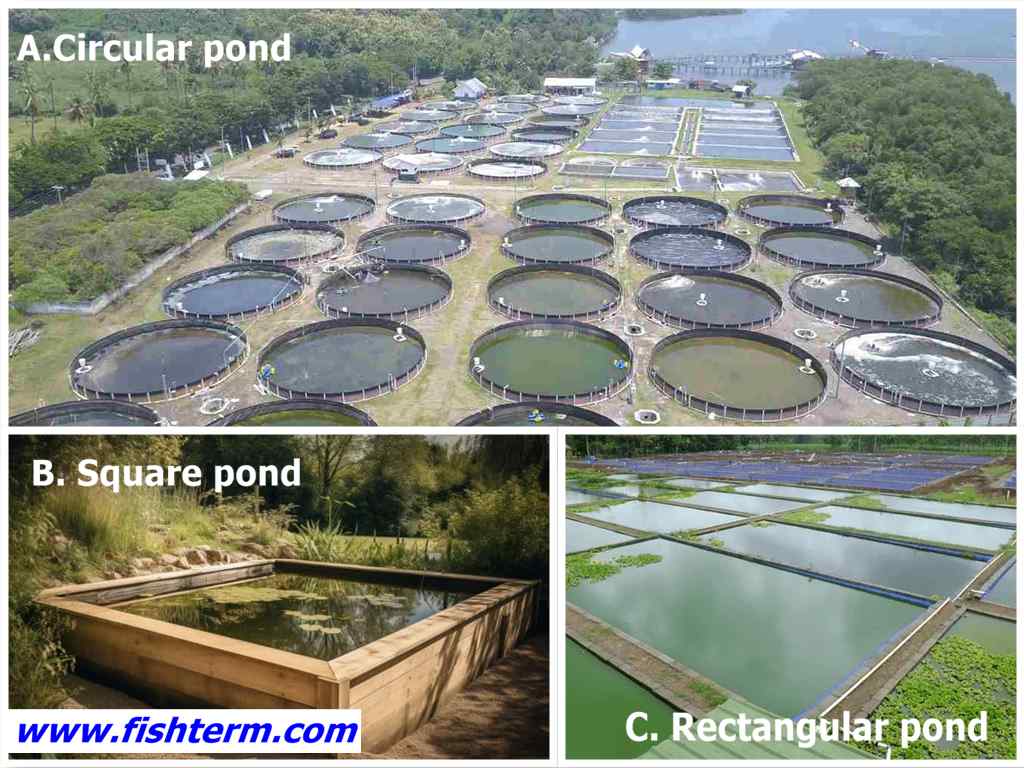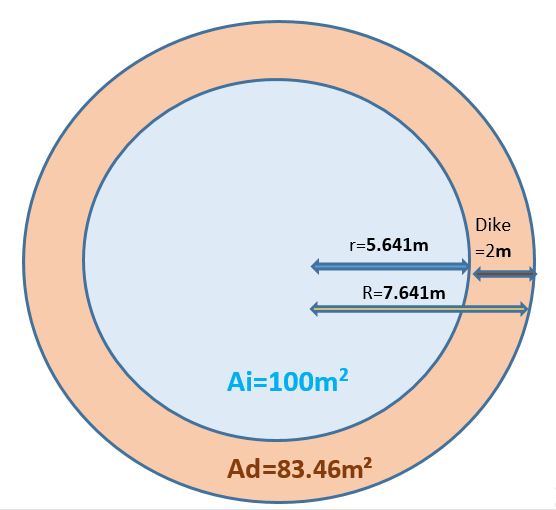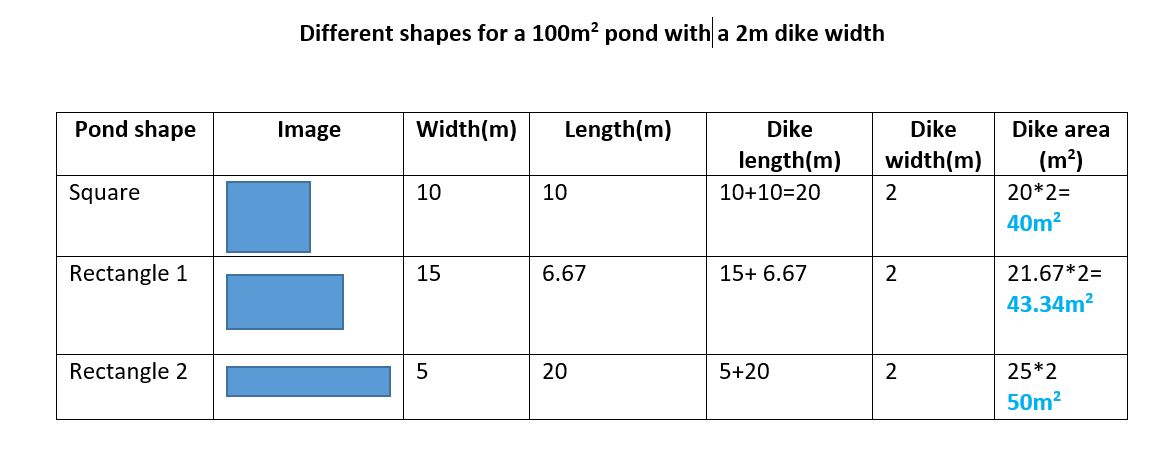How pond shape is affecting your fish production

A fishpond may be constructed in various shapes depending on the topography and space available for pond construction. Based on the site topography, you can decide which pond shape to adopt in certain areas. A fish pond may have any shape, as seen from barrage ponds, whose shape depends exclusively on the topography of the valleys in which they are built.
Various Pond Shapes
Ponds can have a regular shape (circular, square, or rectangular ponds) or may simply be designed irregularly to occupy the land available. Any pond that is neither a circle, square or rectangle will generally be classified as an irregular pond – a typical example of an irregular pond is a barrage pond. The water settles to occupy the shape of the land above the barrage.
Let us examine the main regular pond shapes. They include:
- Rectangular ponds: ponds whose length is longer than its width;
- Square ponds: ponds whose length and width are equal;
- Circular ponds: ponds whose walls or dikes enclose to form a circle;
Comparing the various regular pond shapes
What pond shape do you eventually choose? A round pond? A tight and rectangular pond shape? Or rather a naturally shaped pond (irregular pond)? Before we dive into comparing the various shapes, let us understand some facts. As a matter of fact, choosing a particular pond shape is a matter of taste, culture, and preference. A shape may be chosen because of the design of the remaining part of the garden/farm. Besides, for most ponds, the shape may not be of importance. Except for koi ponds, where the shape is very important indeed. The water in a pond should stream to the effect that the waste goes to the skimmer(s) or bottom drain(s) of the pond.
A lot of questions are asked by aquaculturists when trying to choose the suitable pond shape to adopt for their farm. Between Circular, square, and rectangular ponds:
- which is the cheapest to build?
- which will occupy the least space possible yet deliver optimum yields?
- which is easier to access and manage, especially during the feeding of fish?
- which of the pond shapes favours rapid water renewal and easy circulation of water in the pond?
2. Which pond shape is the cheapest to build?
Generally, sunken ponds and diversion ponds are designed with a regular shape, either square or rectangular. Scientifically, for the same pond size, the total dike length regularly increases as the pond shape gradually deviates from square and becomes more elongated. Therefore, since the narrower the pond the more the space occupied by the dyke, it will imply that rectangular ponds are more costly and occupy more land space than square ponds. Let’s find out that by calculating the dike area for circular, rectangular, and square ponds!
Assuming we want to construct a pond with an area of 100m² having a dike of 2m in a circular, square, and rectangular shape. Below is the calculation for each shape.
2.a. For a circular pond with an area of 100m2
Consider a circular pond as having two circles as shown in the image below
Using the formula
A=πr2

Since the area of the pond is the same as that of the inner circle, let’s calculate the area of the inner circle, Ai, with radius r.
| Ai=100m2
From the formula above, solving for r gives r ≈ 5.6419m. Now, let’s calculate the area, Ao, of the outer circle with radius R: R=r+2m=5.6419m + 2m=7.6419m; Thus, A0=πR2, which implies, A0=π(7.6419)2 Solving for Ao gives, Ao= 183.46m² To get the area of the dike, Ad, we subtract Ai from Ao. Thus Ad= 183.46 -100=83.46m² |
Now that we already know the area of our circular pond’s dike, let’s move ahead to determine the area of our square and rectangular ponds’ dike in the following section.
1.b. For a rectangular and square pond with an area of 100m2

| Dike area for a 100m² square pond:
Area of square dike will be (Perimeter of dike)*(width of dike); Which implies, (length + width)*(width of dike), which gives (10m + 10m)*(2m); Thus, area of its dike = 40*2=40m2 Dike area for a 100m² rectangle pond (rectangle 1): Area of rectangle 1 dike will be (Perimeter of dike)*(width of dike); Which implies, (length + width)*(width of dike), which gives (15m + 6.67m)*(2m); Thus, area of its dike = 21.67*2=43.34m2 Dike area for the second 100m² rectangle pond (rectangle 2): Area of rectangle 2 dike will be (Perimeter of dike)*(width of dike); Which implies, (length + width)*(width of dike), which gives (5m + 20m)*(2m); Thus, area of its dike = 40*2=80m2 |
From the calculations above, we can see that the dike occupies the largest area with a circular pond (i.e. 83.46m²), followed by the narrow rectangular pond (50m2), thirdly by the less narrow rectangular pond (43.34m2), and then the least area with the square pond(40m2).
Let us go back to our question. We can then draw the following conclusions about the cost of the various fish pond shapes:
- As regards the cost of land, we may conclude that a circular pond is the most expensive followed by a rectangular pond, while a square pond is the cheapest.
- You will also find that compared with circular ponds, rectangular and square, ponds are much more cheaper if you can build a group of them, with shared walls/dikes. When circular ponds are joined to each other, there is always an interlogged portion of land that would have been exploited, causing more waste of land.
- It requires more technical skills to carefully curve out the walls of a circular pond to come out linear and smooth – especially when it is an earthen pond. At the same time the construction costs increase.
The above points go a long way to support the many reasons why circular earthen ponds are rarely constructed, especially jointly with each other.
2. which pond shape will occupy the least space possible yet deliver optimum yields?
From the analysis in the above section, it is crystal clear that circular ponds occupy the most space, and square ponds occupy the least. There are cases where it may be simpler and cheaper to match the shape of the pond with the existing topography.
3. Which shape is easier to access and manage?
In Figure 2 above you notice that the center of the pond can be easily attained with the narrower rectangular pond. This means that during manual feeding, the feed can easily reach the pond organisms at the pond’s center from either side of the dike length.
4. Which pond shape favours rapid water renewal and easy circulation of water in the pond?
When it comes to water renewal and easy streaming, the idea is to eliminate dead spots ( hypoxia or low oxygen areas) in the pond. The best circulation occurs when there are no angles in the ponds. That makes a circular pond is more preferable because its walls do not have angles to give room for dead spots. Between rectangular and square ponds, if the water flow is parallel to the pond length, we should note that, the slimmer the pond, the more the water circulation. This is seen with raceways which have high water renewal and oxygenation.
Tips on pond shapes
Below are some tips to follow when implementing any pond shape of your choice:
- Allow good access paths around the pond for humans and maybe vehicles.
- Avoid complex shapes because they are more time-consuming and expensive.
- Avoid creating tight areas like several angles, where water will have trouble circulating.
Leave a Reply